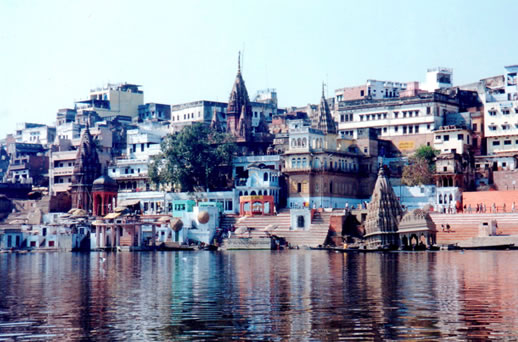
Crossing Over in Varanasi
Above the cremation ghats stands Kedarnath Mandir, Varanasi’s oldest temple. As we entered the otherworldly abode, evening oblations were in progress. Kedarnath, which means ‘field of liberation,’ is at the heart of Varanasi’s crossing over point, and the temple was filled with devout figures absorbed in prayer. The shrine resounded with the resonant tones of brass bells meant to invoke the gods. Thick plumes of smoke wafted about the heavy stone columns like dense fog as worshippers moved noiselessly from altar to altar. Everyone in the temple shared a common purpose; all were preparing to depart this world.
The naturalness with which Indians deal with death and grieving is impressive. Intuitively, people know how to die. It’s really not so different than falling asleep or going into a deep meditation.
It is unfortunate that death is often viewed with uncertainty, confusion, and even fear. After all, death is as much a part of life as birth. While medical science has done much to promote longer, healthier lives in the West, it has also taken the dignity out of dying. I became aware of this sad fact as I watched my dad’s health fail in a nursing home. He was being kept alive by an endless battery of drugs, implanted tubes, and surgical procedures. Finally, after a torturous year, his compassionate Greek physician gathered the family together, and counseled, “I think we should let him go. There will be no quality of life from here on. Life support will be necessary.” In support of dad’s wish not to be kept alive through life support, we consented, and he passed a short time later; but the family was left with the emotional residue of having abetted the termination of his life.
At times during my dad’s ordeal, I wanted to snatch him off to Varanasi. The Indian way, I believed, was more humane than what I observed in my dad’s nursing home where 150 elderly Americans were in as bad or worse condition than my dad, many being kept alive by medical technology alone. The naturalness with which Indians deal with death and grieving is impressive. Intuitively, people know how to die. It’s really not so different than falling asleep or going into a deep meditation. At the same time, the period leading up to it provides an opportunity for the individual to prepare for the soul’s journey. Indians, when they know their time is near, try to balance the ledger of their life, which frees the individual to give his of her undivided attention to matters of the spirit. Believing that the final phase of life should be one of renunciation, Hindus withdraw to spend time in meditation and worship.
